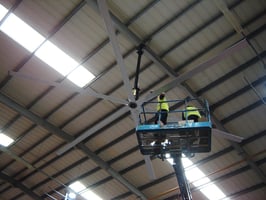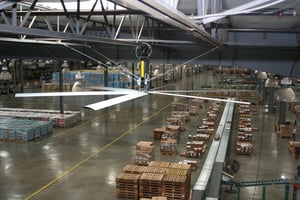High Volume Low Speed (HVLS) fans are a great solution to improve energy efficiency and indoor air...
4 Important HVLS Maintenance Tips
One of the best things about HVLS fans is they don't require a lot of maintenance. Most of the HVLS maintenance tips you'll see in manuals and articles online (including this one) can be executed once a year, or bi-annually if you want to be especially cautious about your equipment.
Here are four procedures that you should make time to complete. They will ensure that your HVLS fans stay in great condition and run for many years:
1. Inspect mounting hardware
Mounting hardware includes bolts, plates, nuts and other components that hold an HVLS fan in place. Make sure that none of these parts have loosened or show any types of cracks or damage.
2. Check the fan's guy wires
Guy wires are often used to give a fan stability and ensure it stays in place, even in extraordinary situations like earthquakes and wind storms. Properly installed guy wires should be taut and not have any frays or loose areas. Ensure that no part of the guy wire is wrapped around or in contact with any sharp edge. Not every fan will have guy wires to check – it depends on the specific HVLS fan mounting system in place.
3. Examine the fan's safety cables
Safety cables provide a failsafe in case something happens that causes the fan's mounting equipment to fail. A safety cable will either be wrapped around the building structure and the fan's frame or come out of the top of the fan and wrap around the building structure. Check your safety cable for any tears or signs of looseness or weakness.
4. Clean any excessive dust or debris
It can be easy to neglect cleaning your HVLS fans. This is because they are far out of reach. Plus, they can function normally even with a heavy layer of dirt covering them. Depending on the environment there may be an excessive amount of dust or manufacturing debris on or around the fan which could affect its ability to function properly. However, in this situation it would be prudent to clean off any excess dirt off the fan and the blades. High-end HVLS fans use anodized blades to prevent damage or staining from dirt or moisture and do not require frequent cleaning. However, like any machine with moving parts, it’s best not to get too much dirt between those parts.
Maintenance Maximizes Your HVLS Fan
Keep in mind that every fan is different: for best results, follow the care and maintenance tips provided by your fan's manufacturer. Also, be sure you have the tools needed to make any minor repairs, including a utility ladder, socket wrench, and spare bolts and nuts. If you keep up with these HVLS maintenance tips, your fan will take care of you and your environment comfortable for less money.

